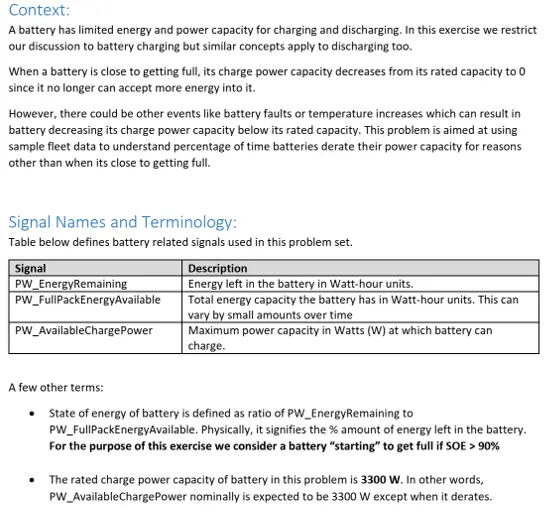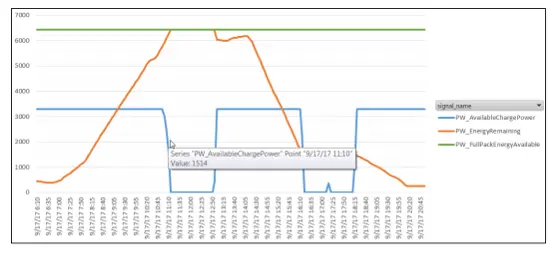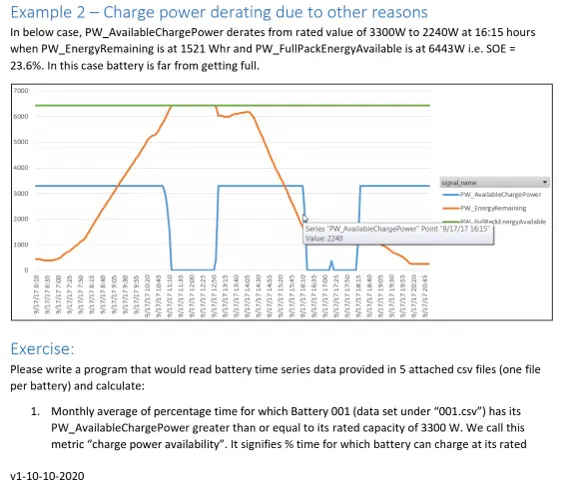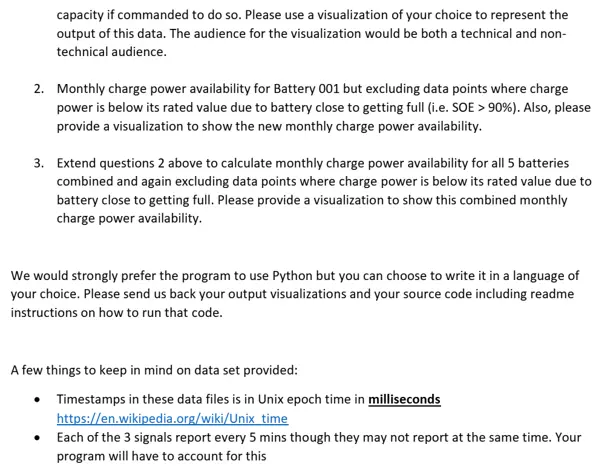Instructions
Objective
Requirements and Specifications





Source Code
# -*- coding: utf-8 -*-
"""AliAssignment.ipynb
Automatically generated by Colaboratory.
Original file is located at
https://colab.research.google.com/drive/1yjeu4fehoNOo9yxnmp5S0CQ31ScBoRlG
"""
import pandas as pd
import numpy as np
import matplotlib.pyplot as plt
from datetime import datetime
"""## Read files"""
# Store data in dictionaries
battery = dict()
for i in range(1, 6):
if not i in battery:
battery[i] = {
'PW_EnergyRemaining': {'timestamps': [], 'values': []},
'PW_FullPackEnergyAvailable': {'timestamps': [], 'values': []},
'PW_AvailableChargePower': {'timestamps': [], 'values': []},
'SOE': {'timestamps': [], 'values': []}
}
ile_name = '00' + str(i) + '.csv'
df = pd.read_csv(file_name)
# Drop NaN rows
df = df.dropna()
# Iterate through rows
for index, row in df.iterrows():
timestamp = row['timestamp']
signal_name = row['signal_name']
value = row['signal_value']
battery[i][signal_name]['timestamps'].append(datetime.fromtimestamp(timestamp/1000))
battery[i][signal_name]['values'].append(value)
# Calculate SOE
for j in range(min(len(battery[i]['PW_EnergyRemaining']['values']), len(battery[i]['PW_FullPackEnergyAvailable']['values']))):
x = battery[i]['PW_EnergyRemaining']['values'][j]
y = battery[i]['PW_FullPackEnergyAvailable']['values'][j]
battery[i]['SOE']['timestamps'].append(battery[i]['PW_EnergyRemaining']['timestamps'][j])
battery[i]['SOE']['values'].append(x/y)
"""
print(f"Battery {i}")
for signal_name in battery[i]:
print(f"There are {len(battery[i][signal_name]['values'])} values for {signal_name}")
print("\n")
"""
"""## Task 1
For battery 1, compute Monthly Average of percentage time for which Battery 001 has its PW_AvailableChargePower greater than or equal to its rate capacity
"""
print("\n*** TASK 1 ***")
months = {}
month_counter = {}
for i in range(len(battery[1]['PW_AvailableChargePower']['values'])):
val = battery[1]['PW_AvailableChargePower']['values'][i]
month = battery[1]['PW_AvailableChargePower']['timestamps'][i].month
if val >= 3300:
months[month] = months.get(month, 0) + 1
month_counter[month] = month_counter.get(month, 0) + 1
# Now, calculate average
for month in months:
months[month] = months[month] / month_counter[month]
# Print
print("For month {} the average percent of time for which PW_AvailableChargePower >= Rate Capacity is {:.2f}%".format(month, months[month]*100.0))
x = list(months.keys())
y = list(months.values())
y = [i*100.0 for i in y]
plt.figure(1)
plt.bar(x, y)
plt.xlabel('Month')
plt.ylabel('Percentage of time (%)')
plt.title('Monthly Average of Percentage Time of availability for Battery 1')
plt.show()
"""## Task 2
Calculate monthly charge power availability
"""
print("\n*** TASK 2 ***")
months = {}
month_counter = {}
for i in range(len(battery[1]['PW_AvailableChargePower']['values'])):
val = battery[1]['PW_AvailableChargePower']['values'][i]
month = battery[1]['PW_AvailableChargePower']['timestamps'][i].month
SOE = battery[1]['SOE']['values'][i]
if SOE < 0.9:
months[month] = months.get(month, 0) + val
month_counter[month] = month_counter.get(month, 0) + 1
# Now, calculate average
for month in months:
months[month] = months[month] / month_counter[month]
# Print
print("The monthly charge power availability for month {} is {:.2f} W".format(month, months[month]))
# Show bar plot
x = list(months.keys())
y = list(months.values())
plt.figure(1)
plt.bar(x, y)
plt.xlabel('Month')
plt.ylabel('Power (W)')
plt.title('Average Charge Power Availability')
plt.show()
"""## Task 3"""
print("\n*** TASK 3 ***")
n = 3
months = {}
months_counter = {}
for i in range(1, 6):
print(f"Battery {i}")
for j in range(len(battery[i]['SOE']['values'])):
val = battery[i]['PW_AvailableChargePower']['values'][j]
month = battery[i]['PW_AvailableChargePower']['timestamps'][j].month
SOE = battery[i]['SOE']['values'][j]
if SOE < 0.9:
months[month] = months.get(month, 0) + val
month_counter[month] = month_counter.get(month, 0) + 1
# Now, calculate average
for month in months:
months[month] = months[month] / month_counter[month]
# Print
print("The monthly charge power availability for month {} is {:.2f} W".format(month, months[month]))
# Show bar plot
x = list(months.keys())
y = list(months.values())
plt.figure(n)
plt.bar(x, y)
plt.xlabel('Month')
plt.ylabel('Power (W)')
plt.title(f'Average Charge Power Availability between all batteries')
plt.show()
print("\n")
n = n + 1
Similar Samples
Explore our curated samples at ProgrammingHomeworkHelp.com, showcasing our proficiency in Java, Python, C++, and more. Each assignment exemplifies our dedication to clarity, efficiency, and precision in programming solutions. Discover how our samples can guide you towards mastering programming concepts and achieving top grades.
Python
Python
Python
Python
Python
Python
Python
Python
Python
Python
Python
Python
Python
Python
Python
Python
Python
Python
Python
Python